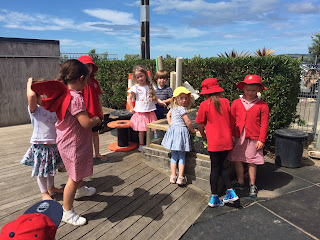Play-based
learning is exactly as it sounds- learning through play and seems to have taken
New Zealand schools by storm.
This
is not a new way of learning and could be seen in action in our primary schools
during the 80’s and 90’s, and was called ‘Developmental’. It was a time
of play and took place in every junior classroom on every day. It was recognized as an important tool to encourage social skills and positive
relationship building.
It
is also seen successfully in our kindy’s and preschools and forms part of the
important Te Whariki which is the Ministries guidelines for pre schools. It
states that in a child's early years they will experience a curriculum that
empowers them as life long learners. Children in pre-schools can choose from a
variety of carefully thought out activities and they rove from
one to the other as their interest levels develop.
Unfortunately
this is where play stopped as once children turned 5 and hit primary school the
emphasis changed to an academic focus, National Standards, where there
was little time to ‘play’. It is now being recognized that we are missing
something and we need to find it again…so Play-Based learning is here.
Today too much of our children's
time is being organised- structured, there is little time for play. There
are numerous lessons to attend after school as well as in school and any free
time is often spent looking at a screen which can mean little interaction with
other people.
We
see break downs in our playgrounds when children cannot relate socially to one
another and when problems arise, do not have the skills needed to work to
resolve them.
Play
is where relationship building takes place, conflict resolution happens, where
children can work out their differences-problem solve and learn how to get
along with each other and how to talk to each other.
The
National Curriculum identifies several values that we strive to teach our
children. Almost all can be developed through a play-based
approach. Innovation, inquiry, curiosity and sustainability. Not to
mention the Key Competencies of Respect, Thinking using language, Managing
Self, Relating to others and Participating and Contributing are all seen when
children are playing.
We
want to develop children that are rich in creativity and innovation. How
better can we encourage this than through a program that encourages children
using their imaginations, exploring and inventing, discovering new ideas and
putting these into action. This is when we see our children talking,
discussing, negotiating, risk-taking and working out ways through a difficulty
or a problem. We also see conflict and arguments but isn’t that an
important part of social development? Seeing and feeling what the effect
of our words, emotions and actions have on other people and developing
relationships through this.
So
how do we see this working in a Year 2 classroom at Haumoana School?
Play
happens spontaneously every morning before school with a variety of
blocks. The children arrive at school, get themselves organised for the
day and immediately start creating. Other children arrive and either join
in or start their own creation. They talk, laugh and begin their day on a
positive note. I have added old boxes of wooden quisenaire blocks to the
mix and now these have become impressive towers or roads linking up their
fortresses.
Now
the job is to look at other types of play and when and how to integrate it into
our school day.
- Construction- blocks-duplo,
wooden blocks, quisenaire, lego, wooden offcuts
- Art station- water colour
paints, scissors, pencils, stencils, magazines, stapler, glue guns, small
boxes, collage materials, paper, cardboard, play dough
- Imaginary- puppets, puppet
theatre, sock puppets, finger puppets, dolls, soft toys
- Games- chunk stacker, snakes
and ladders, maths games, tic tac toe,
- Research- topics, i-pad,
computer, booklets
- Reading- topic box, library
I
will explicitly teach the children about ‘Play-time’ in our class, where and
when it can happen. The choices of play and the rules around it. An
important understanding for the class will be that their work must be completed
to an appropriate standard before play happens. This will involve looking
at exemplars and making them aware of the criteria expected before they begin
their tasks.They must be respectful of their noise level and other workers and
they must also be mindful of tidying up their ‘creations’ before they finish or
move onto something else. There will be 2 lists- Must Do’s and Can do’s
to guide them.
One
type of play will be introduced at a time. The rules around it created
and the organisation around where it can best happen will be discussed.
Sustainability
also needs to be woven into the fibre of play-based learning. There needs
to be thought around our practices and how best to care for the planet through
informed decisions and actions. Creations need to be thought out, purpose, use,
benefit and what they will do with it once completed.
Friday’s
sessions of Discovery will see the children further developing their play and
different opportunities will be offered. Wood table, water play, outside
sporting activities and gardening to name a few. There will be a theme or a
challenge to build activities around as well as discussion around a social
skill/key competency that will be focused on. I will work with the children to
plan these sessions. This is already seen in action with children finding
articles in journals and other resources which they are keen to develop further
during this time. We will join with the other Junior classes which also
encourages a building of different relationships amongst our children.
There will be a reflection session at the end of the morning where they will be encouraged to share
thoughts or items that they have created during the session.
These are great examples of play-based activities where the children have created some super self -initiated creations.

























































